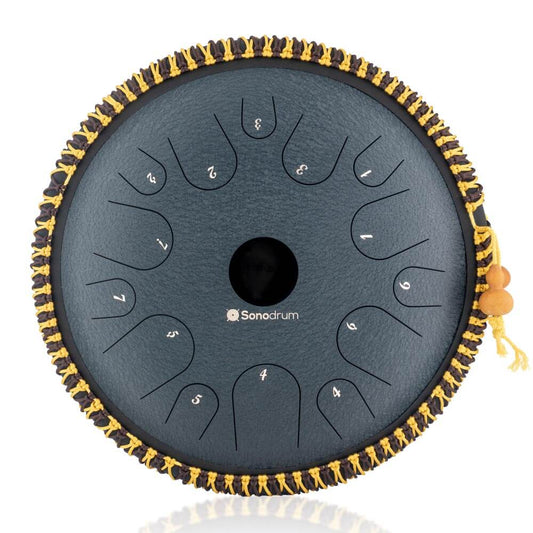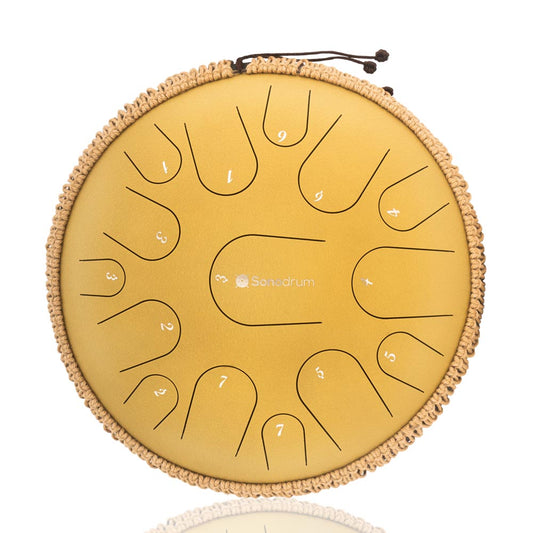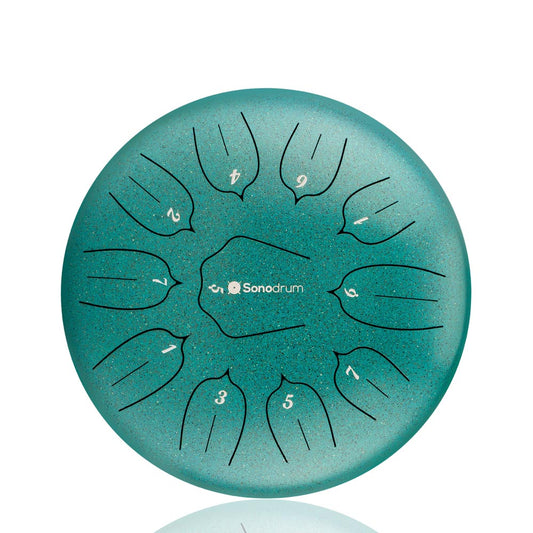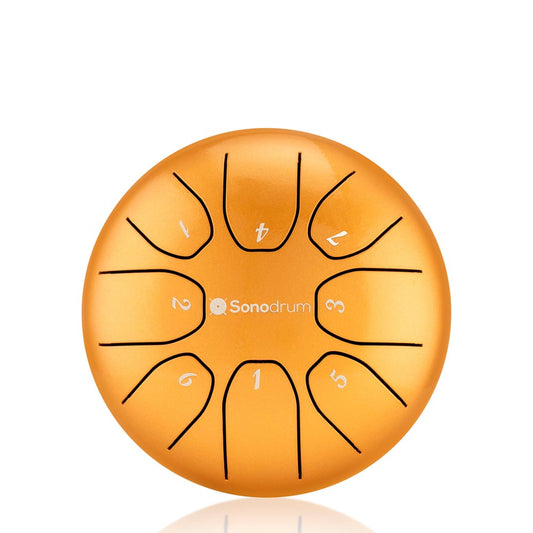The handpan is a fascinating and unique musical instrument that has gained popularity in recent years. Its distinct sound and captivating appearance make it a favorite among musicians and enthusiasts alike. If you're interested in learning how to play the handpan, this beginner's guide will provide you with the essential steps to get started and develop your skills.
How to Play Handpan: Mastering the Basics in Just a Few Steps
 The handpan is a mesmerizing instrument that produces ethereal and enchanting sounds. If you're eager to learn how to play the handpan and master its basics, this guide will provide you with a streamlined approach to get started on your musical journey.
The handpan is a mesmerizing instrument that produces ethereal and enchanting sounds. If you're eager to learn how to play the handpan and master its basics, this guide will provide you with a streamlined approach to get started on your musical journey.
Step 1: Familiarize Yourself with the Handpan
- Take some time to examine the instrument and understand its layout. Observe the different notes and their positions on the handpan's surface.
- Listen to various handpan performances and recordings to develop an ear for the instrument's unique tonal qualities and melodic possibilities.
Step 2: Find Your Hand Position and Technique
- Sit comfortably with the handpan placed on your lap or on a stand at a suitable height.
- Relax your hands, arms, and shoulders to achieve a fluid playing motion.
- Experiment with different hand positions and striking techniques. Start with using your fingertips and gradually explore striking with other parts of your fingers for different tones and sounds.
Step 3: Begin with Basic Scales
- Choose a simple scale to start with, such as the C Major or D Minor scale.
- Gently strike each note of the scale, paying attention to the sound and resonance produced.
- Practice playing the scale up and down, gradually increasing your speed and accuracy.
Step 4: Explore Melodies
- Once you're comfortable with playing scales, start exploring simple melodies within the chosen scale.
- Experiment with ascending and descending patterns, and try to create melodic phrases using different combinations of notes.
- Play the melodies slowly at first, gradually increasing the tempo as you become more proficient.
Step 5: Develop Rhythm and Groove
- Work on developing your sense of rhythm by incorporating rhythmic patterns into your playing.
- Start with basic rhythms, such as a steady pulse or simple subdivisions.
- Gradually experiment with more complex patterns, syncopations, and polyrhythms to add depth and variation to your playing.
Step 6: Focus on Dynamics and Expression
- Explore the dynamic range of the handpan by practicing playing notes softly and loudly.
- Experiment with using the sustain of the notes to create expressive phrases and emotional nuances in your playing.
- Pay attention to the subtle changes in touch and pressure required to produce different dynamics.
Step 7: Record and Evaluate Your Progress
- Record your practice sessions to listen back and evaluate your playing.
- Take note of areas where you can improve, such as timing, accuracy, or fluidity.
- Use recordings as a tool for self-assessment and to track your progress over time.
Step 8: Expand Your Horizons
- Collaborate with other musicians or join jam sessions to explore new musical possibilities.
- Learn from experienced handpan players and seek inspiration from different genres and styles of music.
- Continuously challenge yourself by incorporating new techniques, scales, and rhythms into your repertoire.
Handpan Playing Techniques: Tips and Tricks for Beginners
 Mastering handpan playing techniques is essential for unlocking the full potential of this captivating instrument. Whether you're a beginner or have some experience, these tips and tricks will help you develop your skills and enhance your handpan playing.
Mastering handpan playing techniques is essential for unlocking the full potential of this captivating instrument. Whether you're a beginner or have some experience, these tips and tricks will help you develop your skills and enhance your handpan playing.
Warm-Up Exercises:
- Before diving into playing the handpan, it's important to warm up your hands and fingers. Stretching exercises, finger rolls, and gentle wrist rotations can help increase flexibility and prevent strain or injuries.
Hand Placement and Posture:
- Maintain good hand placement and posture to optimize your playing technique:
- Relax your hands and maintain a light touch on the handpan's surface.
- Keep your fingers slightly curved and avoid excessive tension.
- Sit comfortably with proper back support to maintain an upright posture.
Experiment with Different Striking Techniques:
- Explore a variety of striking techniques to produce different sounds and tones:
- Fingertip Strike: Use the pads of your fingertips to strike the notes. This technique produces a clear and resonant sound.
- Finger Pad Strike: Strike the notes with the pads of your fingers, allowing for a softer and mellower sound.
- Knuckle Strike: Experiment with striking the notes with the base of your fingers or knuckles to achieve a percussive and robust tone.
- Combination Strikes: Combine different striking techniques within a single melody or rhythm to add texture and variation to your playing.
Focus on Dynamics:
- Develop control over dynamics (volume) to bring depth and expression to your playing:
- Soft Strikes: Practice playing notes softly by using a light touch. This allows for delicate and introspective melodies.
- Accentuated Strikes: Experiment with striking certain notes with more force to create accents and emphasize specific beats or phrases.
- Gradual Dynamics: Explore playing notes with a gradual increase or decrease in volume, allowing for smooth transitions and dynamic expression.
Hand Muting and Damping:
- Mastering hand muting and damping techniques adds versatility to your playing:
- Hand Muting: Place your hand lightly on a note after striking it to immediately stop its sound. This technique is useful for creating staccato effects or silencing specific notes within a melody.
- Hand Damping: Rest your hand gently on multiple notes to dampen their resonance. This technique can be used to create a muted or percussive effect.
Explore Different Playing Surfaces:
- Experiment with striking different areas on the surface of each note to produce varying sounds:
- Center Strike: Striking the center of a note produces a bright and focused tone.
- Rim Strike: Striking near the rim of a note creates a softer and warmer sound.
- Tone Field Strike: Explore striking different areas between the center and rim to discover unique tonal qualities.
Utilize Harmonics and Overtones:
- Discover the rich harmonics and overtones that the handpan can produce:
- Harmonic Strikes: Strike a note gently and allow the harmonic tones to resonate. These higher-pitched sounds add complexity and depth to your playing.
- Overtone Control: Experiment with different striking techniques and hand placements to manipulate and control the overtone series of the handpan. This can lead to intricate and beautiful harmonic interplay.
Practice with a Metronome or Backing Tracks:
- Develop your sense of timing and rhythmic precision by practicing with a metronome or playing along with backing tracks. This helps build a solid foundation for your rhythmic abilities and improves your ability to play in sync with other musicians.
Unlock the Mysteries of Handpan: A Step-by-Step Guide to Playing
 The handpan is a captivating instrument that evokes a sense of wonder and beauty. If you're intrigued by the mysteries of the handpan and eager to learn how to play, this step-by-step guide will help you navigate the instrument and embark on your musical journey.
The handpan is a captivating instrument that evokes a sense of wonder and beauty. If you're intrigued by the mysteries of the handpan and eager to learn how to play, this step-by-step guide will help you navigate the instrument and embark on your musical journey.
Step 1: Understand the Handpan
- Familiarize yourself with the handpan's unique construction, including the shape, notes, and resonant chambers.
- Learn about the different scales and tunings available and choose one that resonates with you.
Step 2: Embrace Proper Hand Technique
- Sit comfortably with the handpan positioned securely on your lap or a stand.
- Relax your hands, wrists, and arms to achieve fluidity and control.
- Use a light touch when striking the notes to allow them to resonate fully.
Step 3: Explore Basic Hand Strikes
- Start with the fundamental hand strikes: using your fingertips, pads of your fingers, or the base of your fingers.
- Experiment with different striking techniques to produce varying tones and dynamics.
- Try different angles and positions to find the sweet spot that produces the desired sound.
Step 4: Learn Basic Scales and Melodies
- Begin by learning basic scales such as the C Major or D Minor.
- Practice playing the scale up and down, familiarizing yourself with the arrangement of notes.
- Experiment with playing simple melodies within the chosen scale to develop your musicality.
Step 5: Develop Rhythmic Skills
- Work on your sense of rhythm by practicing rhythmic patterns.
- Start with basic beats and gradually incorporate more complex rhythms.
- Use a metronome or play along with backing tracks to improve your timing and groove.
Step 6: Understand Handpan Resonance and Sustain
- Explore the resonant properties of the handpan by allowing the notes to ring and sustain.
- Experiment with different striking techniques and hand placements to control the sustain and resonance.
- Learn to use the sustain creatively, incorporating pauses and rests into your playing for added expression.
Step 7: Cultivate Expressiveness
- Focus on dynamics by varying the intensity and volume of your strikes.
- Experiment with subtle nuances in touch and pressure to bring out the desired expression in your playing.
- Use vibrato, slides, and glissandos to add color and emotion to your melodies.
Step 8: Expand Your Repertoire and Collaborate
- Continuously explore new scales, melodies, and rhythms to expand your repertoire.
- Listen to different styles of music and incorporate elements that inspire you into your own playing.
- Collaborate with other musicians, experiment with improvisation, and explore the possibilities of ensemble playing.
Step 9: Embrace Practice and Patience
- Dedicate regular time to practice, even if it's just a few minutes each day.
- Be patient with yourself and embrace the learning process.
- Celebrate small victories and milestones along the way to stay motivated.
Conclusion
In conclusion, learning how to play the Handpan is an exciting and fulfilling journey that offers endless possibilities for musical expression. By following the steps outlined in this guide, you can develop a solid foundation and gradually build upon your skills. Remember to practice regularly, experiment with different techniques and scales, and embrace collaboration with other musicians. As you progress, take time to reflect on your playing, record your performances, and celebrate your achievements. Enjoy the enchanting sound of the Handpan and let your passion for music guide you as you continue to explore and master this captivating instrument.
FAQs
Do I need any prior musical experience to play the handpan?
While prior musical experience can be beneficial, it is not necessary to play the handpan. The instrument is accessible to beginners, and with practice and dedication, anyone can learn to play and create beautiful melodies.
How do I choose the right handpan for me?
Choosing the right handpan involves considering factors such as your budget, preferred scale or tuning, and the sound characteristics you resonate with. Research different handpan makers, listen to their instruments, and if possible, try them out in person to find the one that suits your preferences.
How do I take care of my handpan?
Handpans are made of steel and require proper care to maintain their sound quality and appearance. Avoid exposing the instrument to extreme temperatures, moisture, or direct sunlight. After playing, wipe the handpan with a soft cloth to remove any moisture or fingerprints. It's also recommended to store the handpan in a protective case when not in use.
Can I play the handpan with mallets or drumsticks?
While handpans are primarily played with hands and fingers, some players experiment with mallets or drumsticks for different effects. However, it's important to note that not all handpans are designed to be played with mallets, so it's best to consult the manufacturer's guidelines or seek advice from experienced handpan players before attempting to use alternative playing tools.
How long does it take to learn to play the handpan?
The learning process varies from person to person. With regular practice, it is possible to start playing simple melodies within a few weeks or months. However, mastering the instrument and developing advanced techniques can take years of dedicated practice and exploration.
Can I learn to play the handpan by myself, or do I need a teacher?
It is possible to learn the handpan on your own, especially with the help of online resources, tutorials, and sheet music. However, having a teacher or attending workshops can greatly accelerate your learning process, provide guidance on proper technique, and offer personalized feedback and instruction.
Are there specific handpan playing communities or events I can join?
Yes, there are handpan playing communities and events worldwide. Look for local handpan groups, workshops, festivals, or online communities where you can connect with other players, share experiences, and participate in collaborative sessions. These communities can offer valuable support, inspiration, and opportunities to further develop your skills.
Can I play different styles of music on the handpan?
Absolutely! The handpan is a versatile instrument that can be played in various musical styles, including world music, ambient, jazz, classical, and more. Experiment with different scales, rhythms, and techniques to explore the range of musical genres that can be adapted to the handpan's unique sound.
How do I develop my own playing style on the handpan?
Developing your own playing style on the handpan comes with time and exploration. Experiment with different techniques, scales, rhythms, and dynamics. Listen to a wide range of music, seek inspiration from other instruments, and allow your creativity to guide you. Your personal playing style will evolve naturally as you develop your skills and musical identity.
Where can I find resources for learning handpan playing techniques?
There are various online resources available for learning handpan playing techniques, including tutorial videos, handpan sheet music, online courses, and instructional books. Explore websites, forums, and social media groups dedicated to the handpan community, as they often




